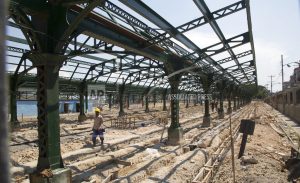Cuba tries to revive its once-great railway network
By CHRISTOPHER GILLETTE Associated Press
HAVANA (AP) — Cuba’s railway system is undergoing a major overhaul, with the government pushing a program to revamp the decrepit and aging network with new cars and locomotives in the hope of restoring a rail service that was once the envy of Latin America.
Cuba’s Ministry of Transportation took possession on Monday of 80 new Chinese-made passenger cars, part of a promised consignment of 250 rail cars and locomotives the island will receive by year’s end.
At the same time, the government is busy restoring and repairing rail lines throughout the island, some with rusting rails overgrown with weeds or buried under drifting dirt.
But the overhaul will be challenging, government officials acknowledge, even with the new Chinese-made rail stock. The remaining equipment, much of it dating from 1975, lies in disrepair on the sides of railyards as the system has seen the number of passengers plunge in recent decades. Some electric trains that provide local links are completely out of service because of aging equipment.

Workers rebuild and refurbish the central station in Havana, Cuba, Wednesday, May 22, 2019. Cuba’s railway system is undergoing a major overhaul, with the government pushing a program to revamp the decrepit and aging network with new cars and locomotives in the hope of restoring a rail service that was once the envy of Latin America. (AP Photo/Ismael Francisco)
And restoring 2,600 miles (4,200 kilometers) of track, communications lines and dozens of crumbling rail stations around the island will be a monumental task.
Workers have been restoring Havana’s main rail terminal, an eclectic structure built in 1912, with four floors and a mezzanine, for over 10 years.
The station’s platforms, which are nearly 1 kilometer (more than half a mile) long, recall a bygone age when train travel was a principle mode of transportation, and the restoration has been a painstaking, and at times frustrating, process, government officials say.
Ricardo Cabrisas, vice president of the Council of Ministers, says the restoration is part of a broader effort to restore the island’s rail system.
“It’s an ambitious plan that matches our long-range goals,” Cabrisas remarked at the ceremony on the outskirts of Havana where the Chinese rail stock was offloaded from a cargo ship, adding the “effort is aimed at providing reliable transportation across the island.”
According to the Cuban Transportation Ministry, trains carried 6.7 million passengers in 2018, a sharp drop from almost 11 million passengers in 2004. The government hopes to increase ridership by 1 million in 2019 on long distance routes. Train service to the far-eastern cities of Santiago, Holguin, Camaguey and Guantanamo are heavily used by locals.
The Havana-Santiago trip costs as little as 32 Cuban pesos each way, about $1.50, making train travel an affordable means of transport for many Cubans.
Cuba Railways General Director Eduardo Hernández says the new program is aimed at providing transportation to locals, but also hopes to lure tourists with the new Chinese rail cars and locomotives, which have two classes of service, including an air-conditioned first-class.
“The recovery program for the Cuban railways runs through 2030, and it includes all aspects of the system, which includes rolling stock to modernizing the communications of the railway system. That’s what we aspire to. We want to restore the central rail system to its original state,” Hernández said.
The trains will service Camaguey and Holguin, important tourist destinations and gateways to the beaches of the island’s offshore keys.
The new first-class cars even boast hostesses, trained to cater to high-paying passengers, along with digital televisions, upholstered reclining seats, gleaming toilets and a restaurant car.
Cuba is the only country in the Caribbean that offers island-wide rail service. It once boasted the first country-wide rail line in Latin America, starting service in 1837 with a 17-mile (27-kilometer) long line built to transport sugarcane.
The Chinese rail cars are the first new equipment received on the island since 2001, when a shipment from French Railways for the Havana-Santiago line was imported, allowing Cuba Railways to offer modern service for its most heavily traveled route.
The remaining rolling stock is a mix of Canadian, German, French, Russian and now Chinese, and despite the push to improve service, Cuba Railways faces a daunting task providing reliable service in the near future.
The journey from Havana to Santiago, roughly 1,000 kilometers (620 miles) east of the capital, can take 20 hours, and sometimes even longer with equipment breakdowns. Most tourists shun the train because of its reputation for slow and shoddy service.
But Yudith Márquez, a hostess for Cuba Railways, was enthusiastic about the new equipment, and says she hopes it’s a sign of better days for the rail service.
“We are confident things will get better, because after so much effort, we are not going to let up. We have been waiting for this for a long time and they have been promising this for long time, the new equipment never got here, for one reason or another. But now, it is finally here,” Márquez said.
[livemarket market_name="KONK Life LiveMarket" limit=3 category=“” show_signup=0 show_more=0]




No Comment